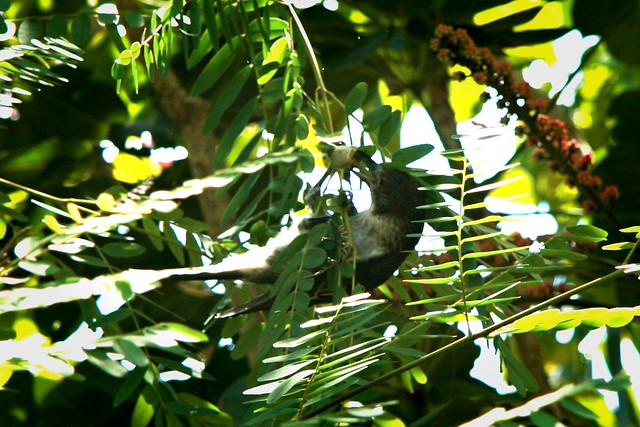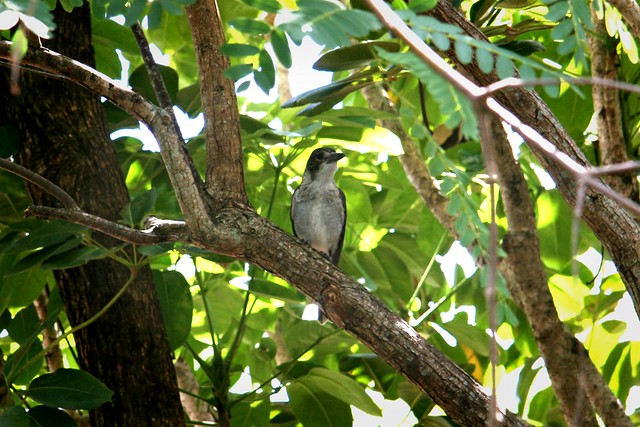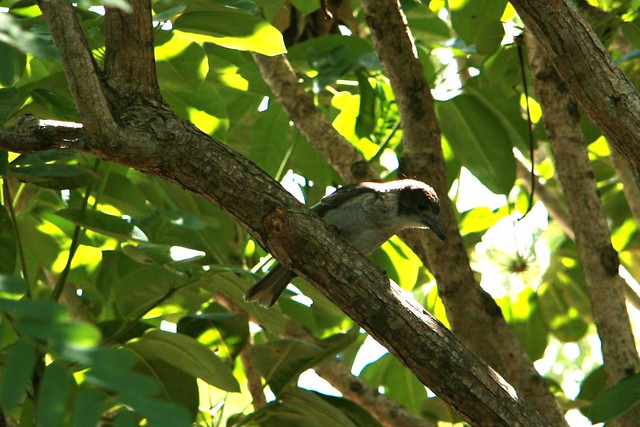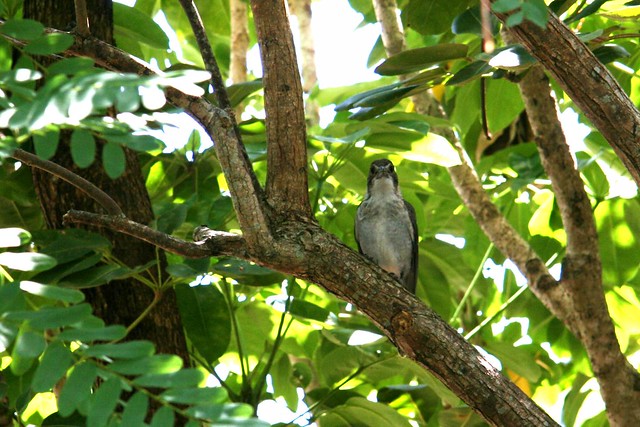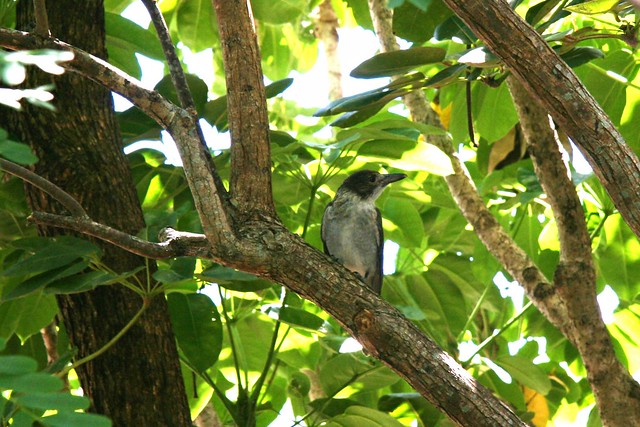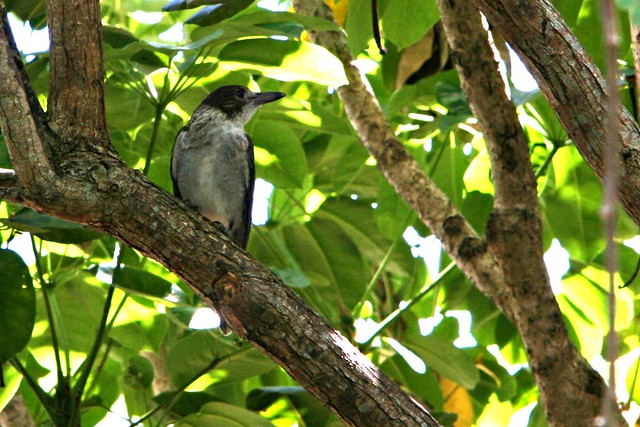
Our family decided to go to the Bunya Mountains for a short break, so I brought my bike and did some exploring of this beautiful part of the world.
Continue Reading
Category: Wildlife
Butcher Bird
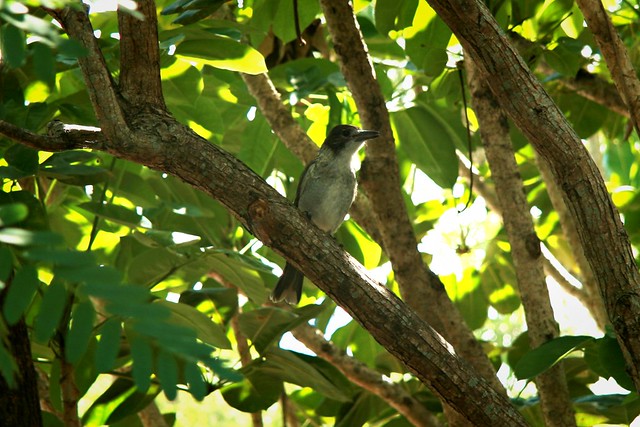
Here’s a few photos I took of a juvenile Grey Butcher Bird (Cracticus torquatus) sitting in a tree at our place this morning.
They have a beautiful song, and are quite agressive in the nesting season. Birds often attack cyclists in the nesting season. A Plover will scream madly at you until you go away (they nest on the ground, and have a lot to lose if thet don’t chase you). A Magpie will give you a warning cry before attacking, and will often snap their beaks close to you, to scare you off. But a Butcher Bird will slam into the side of your head without warning, and then warble happily about it afterwards, as though she was laughing at you: “Gotcha, you nasty cyclist. Stay away! Don’t come back!”.
For the rest of the year they’re fun to watch, and to listen to…
DID YOU KNOW that there was a vindictive court case in Brisbane in 1882 (Spry vs Minchinton) about the theft of a Butcher Bird?
Why Ride?

For my first ride of 2013 I decided on a short tough ride through the familiar trails of Clear Mountain. It has a bit of everything – winding single track, thick forest, fast firetrail descents and tough climbs.


While I was riding on the single tracks, I spied this mushroom in the middle of the track, growing out of a pile of manure left by a horse. I thought I’d try taking a picture of it, but when I did, a fly perched on top of the mushroom. He didn’t budge no matter how I contorted myself to try and get the best picture.
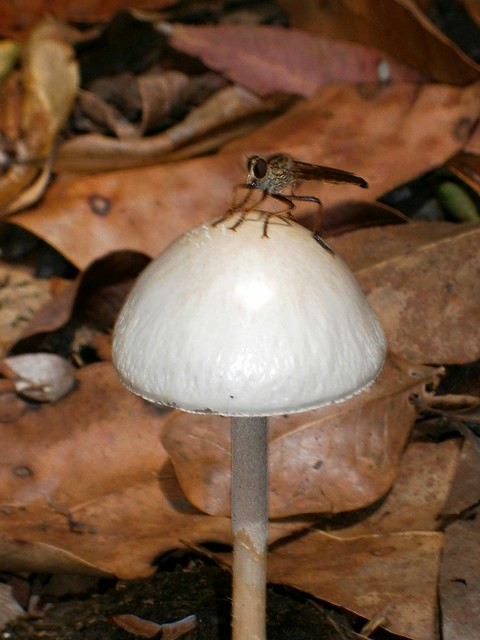
I’ve probably said this to you before, but:
I don’t ride to get fit. That’s just a side-effect.
I don’t ride to break records or win races – even though I sometimes try to grab a KOM or two on Strava.
The thing that keeps me coming back is discovering new things, exploring new places, and sharing those discoveries with my friends. That’s why I really enjoy riding with people, and writing about what we find.
I’ve ridden this track hundreds of times, but I got a buzz out of the fact that on yet another familiar ride I was able to discover something new.
I mean – it’s not every day you get to write about a bug on a mushroom in a pile of manure 🙂
Happy New Year!
Total climbing: 581 m
Average temperature: NAN
Total time: 02:36:37
More data
The Bump Track
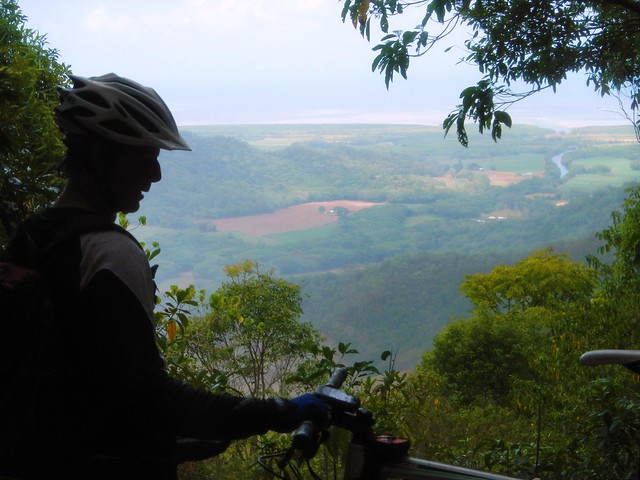
We were staying at Palm Cove between Cairns and Port Douglas to watch the Total Solar Eclipse, which provided an ideal opportunity to explore the spectacular rainforest inland from the coast.
Being an adventurous soul, I thought I’d just hop on the bike and follow my GPS, but I’ve learned to listen to the wisdom of my wonderful wife who insisted I ride with someone who actually knew the area. That was how I met Dan Foley from Dans Mountain Biking. Dan has been mountain biking in Far North Queensland for over twenty years and knows the trails intimately. He operates guided tours by mountain bike through places like Cape Tribulation, Daintree National Park, Bloomfield Track, Atherton Tablelands and Mulgrave Valley. Today he took me through Mulgrave National Park and “The Bump Track”. The rainforest is full of things that eat, sting, bite, slice, and/or kill you, so I’m really glad Dan was there to keep me out of harms way.
Funnily enough, while thinking of all the things that could chew me up, we started our ride from the car park at Hartleys Crocodile Farm at Wangetti.
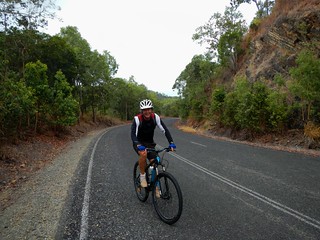

The first part of the ride was up Quaid Road – a disused development road which, over the space of 5km, climbs 500m up from Wangetti on the coast into the rainforest. It was built by property developer George Quaid in the 1980’s just before the area was declared a wet tropics world heritage area. So (thankfully) George didn’t get to carve up the rainforest. The road is gated off – so motor vehicles can’t use it. But it’s a really easy way to get from the coast into the mountains by mountain bike.
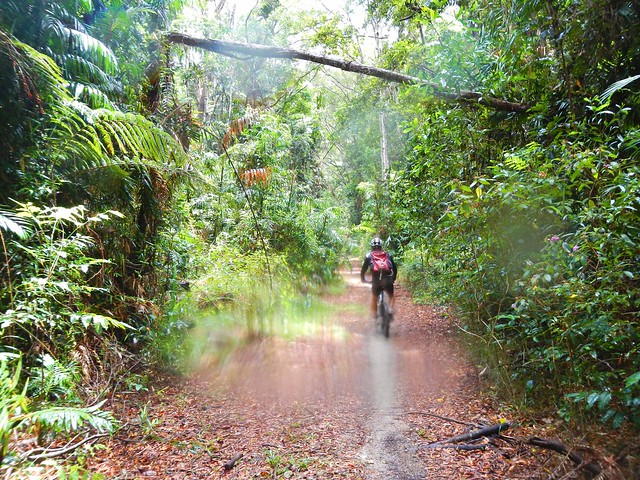
Once we got into the rainforest (emphasis on “rain”) it started raining. Dan took me along the “twin bridges” track – one of the many management trails in the area.

Not far in, we encountered what I thought was a dead snake. “How sad” I thought as I sidled up close to it to take a picture. Dan suggested we give it a wide berth in case it was still alive. I listed to him, and once past it, we poked it gently with a stick. To my great delight the Red Bellied Black Snake (Pseudechis porphyriacus) reared up at us. It was a alive! And so was I for listening to Dan. Those snakes are venomous and can give you a nasty bite.

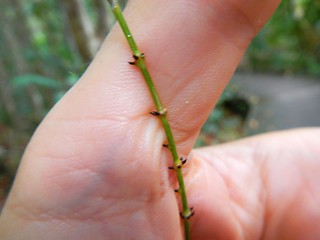
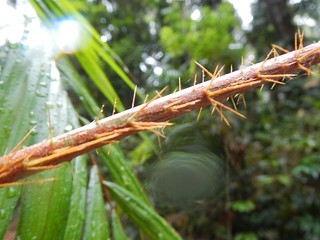
A little further along the track, and Dan stopped me again. This time it was for a Wait-A-While or Lawyer Cane (Calamus australis). This is a species of climbing Palm Tree. It drops long thin spike-covered tendrils down to the forest floor below. They’re tough and sharp. If you ran into one (or tried to ride past one on a bike), the sharp tendrils could inflict horrible damage. Dan told me stories of motor cyclists losing limbs to the plant while speeding through the forest on a trail bike. The dangerous thing is that the tendrils are so thin that they’re nearly impossible to see. And with the rain pouring down, and glasses fogged up, it would have been really easy for me to get snagged on one (or two, or three). Thankfully (for me), Dan rode in front. He hit the vines first. I just made sure I took notice when he pointed them out to me.
Aborigines used the mature cane from the vine as struts to build shelters. They wove the spiky tendrils into snares and fish traps. And by cutting the thick canes they were able to collect drinking water when needed. A one meter long section of the vine, when cut, could supply over a cup of drinkable water.
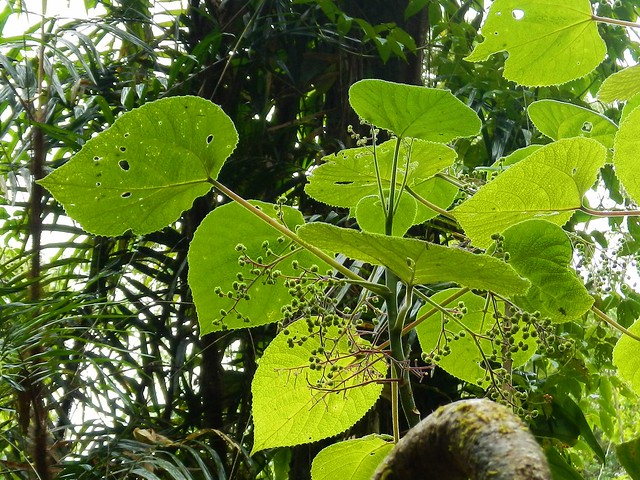
Another nasty surprise in this part of the world is the Gympie Gympie or Stinging Tree (Dendrocnide moroides) – a highly toxic plant that can inflict severe pain at the slightest touch. The cure is duct tape or leg wax applied to the affected area of skin to pull the thin spikes out. The worst thing you can do is rub the area or apply water to it.
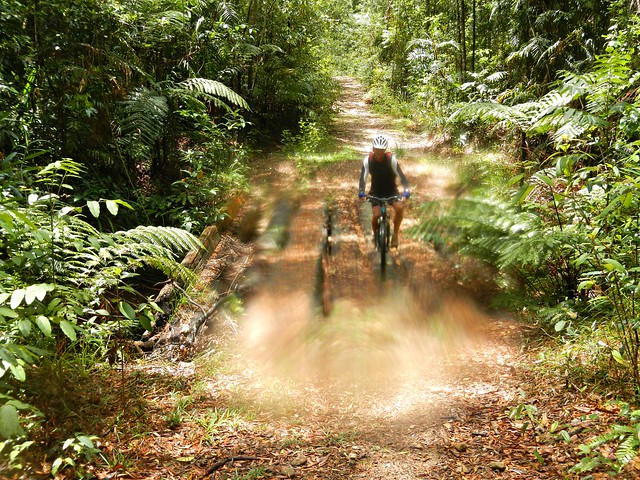
We slowly continued our ride northwards over several log bridges which crossed quiet creeks. The water is crystal clear and is good to drink as well. The trick with log bridges is to make sure you don’t get your wheel stuck in the gap between the logs, so it’s important to “Pick a plank” and stick to it, or run the risk of flying over the handlebars 🙂


The “Twin Bridges” track is named after two large log bridges which used to span Spring Creek. Floodwaters destroyed the bridges a while ago, and all that is left is a large pile of logs. So we had to wade across the creek in thigh deep water. Thankfully there were no crocodiles 🙂
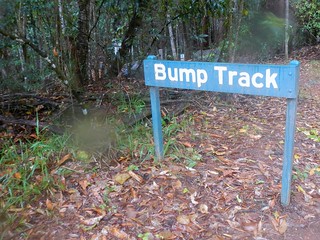
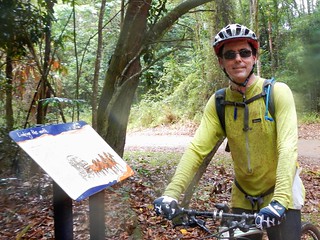
Eventually we reached the top of “The Bump Track”. This track is part of the Bicentennial National Trail and forms part of the route that Cobb & Co took between Port Douglas and Georgetown in the 1880’s. The 322km trip trip used to take five days. When the coach got to the Bump Track, all the passengers had to get out and walk, while the horses dragged the stage coach up the steep hill.

Today we were going DOWN the Bump Track, not up it. At its steepest, the track drops over 300 metres in 1.8 km. My brakes were totally cooked by the time we got to the bottom. So I was glad to stop halfway down to enjoy the view of the Mowbray River to the east, and let the brakes cool down.
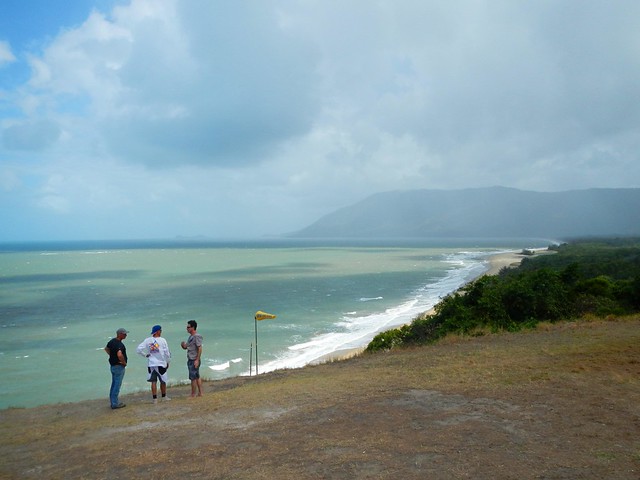
Once at the bottom, we made our way back to the Captain Cook Highway near Port Douglas and made our way south along the bitumen. This must be one of the most scenic highways in the country. On the way back we stopped at Rex Lookout to enjoy an amazing panorama of the coastline to the south.

All up we rode 55km in just over 5 hours including breaks. I burned 5,000 kcal as we ascended a total of 1,250m. On the tough-o-meter I’d rate this ride about 7.5 out of 10 for difficulty, but 10 out of 10 for fun and stunning views.
If you’re new to the area, DON’T do this ride by yourself. Get someone who knows the area, like Dan Foley. When you’re taking on a tropical rainforest with “Wait-A-While” vines, Gympie Gympie plants, Black Snakes, Crocodiles, and log bridges with treacherous gaps, a competent guide will ensure that you arrive home happy and in one piece.
Total climbing: 1304 m
Average temperature: NAN
Total time: 05:12:16
More data
Eagles
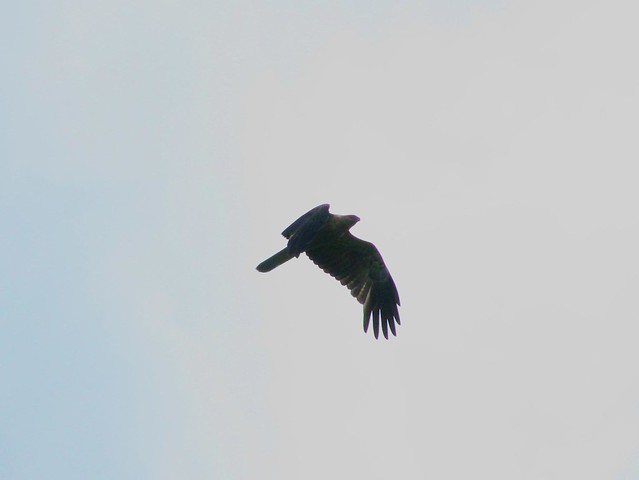
I took Liz’s Canon Powershot camera on my bike ride today in the hope I might spot some wildlife near the dam. As though responding to some cue, these eagles started soaring overhead while I rolled along underneath with my eyes pointing upwards when I should have been watching the track.
Luckily I didn’t hit in obstacles 🙂


These two photos were a bit of a fluke. I hoped the eagles would drift between me and the moon so I could get both in the shot. By some great stroke of luck, that’s exactly what happened.
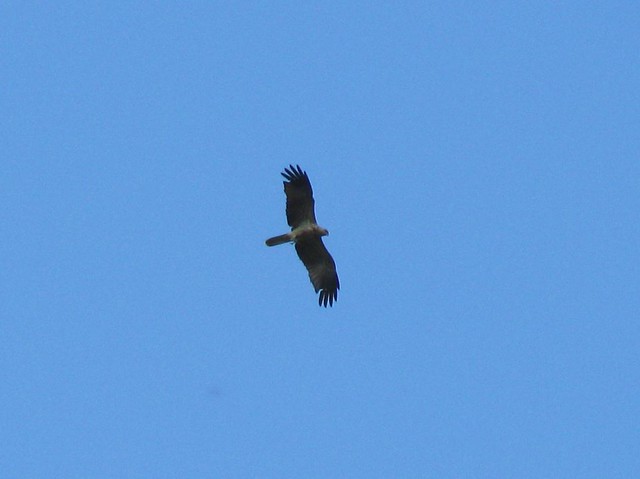
They were effortless – hardly any flapping, just slowly circling overhead. They seemed to be enjoying their flight as much as I was enjoying my ride.
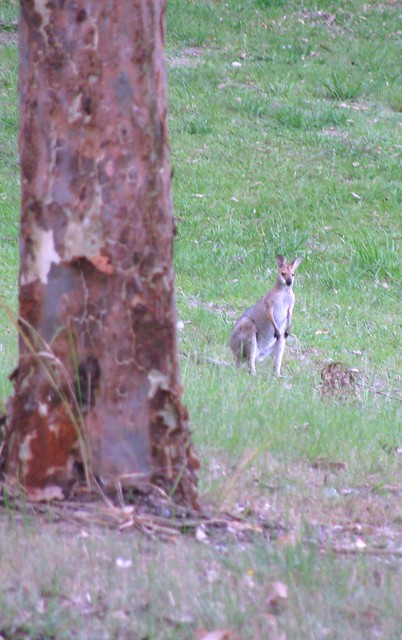
And to top the afternoon off, this shy wallaby stopped long enough for me to get a photo. I kept the tree between me and him, so he couldn’t see me, got the camera ready, stepped sidways into view, and took the shot before he bounded off into the undergrowth.

It’s always a nice ride up by the lake.
Total climbing: 557 m
Average temperature: NAN
Total time: 02:19:48
More data
Lizard at home

Lizard at home
Originally uploaded by MagicTyger
This magnificent lizard has been living at our place for the last few years.
I caught him limping around the other day. It appears he’d been in a fight with either a cat or another lizard, and wasn’t walking very well.
So I called the RSPCA who came out, captured him and took him to their animal hospital.
They tell me when he’s better they’ll bring him back home here, where everything is familiar to him.
Possum Visitor

Possum Visitor
Originally uploaded by MagicTyger
This little visitor decided to visit us at night and scavenge left over food from our deck.
We’ve sometimes caught them grabbing pieces of birthday cake when no one was looking.
Those eyes look almost like LED’s don’t they?




